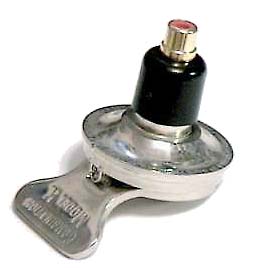
Version: Apr 20, 1999
 |
|
Version: Apr 20, 1999 |
by Rob Lomas, 1999

A few years ago Peter Liebert envisioned an "adapter" that allowed both electric playback as well as acoustic playback with the same reproducer! We built the device together. In principle it is very fine but in reality only someone who makes one can keep it working properly. At the time I had wanted to make my own pickup with strong enough output so that no preamplifier was necessary. With this design the output was enough to use the line input of my stereo, although it was still not as loud as for example my cassette player. The principle is very simple. Attach a small, powerful magnet to the center of the diaphragm, then lower a metal rod that has a coil (several hundred turns) of extremely fine wire (I used 46AWG, the smallest I could work with) wrapped around it. I was very surprised when it worked on the first try! The closer the rod was to the magnet the stronger the output. Unfortunately if the rod came too close, the magnet pulled the diaphragm up and attached itself to the rod, which didn't sound very good at all! To get the volume I wanted the distance was very critical and difficult to keep in adjustment. Some experimentation with screw adjustment to set the depth of the coil/rod in relationship to the magnet should make it possible to make this unit practical. Perhaps later in the year we may make a unit similar to this one, but with lower output so that a preamplifier is still required. This would make the distance from the magnet to the coil less critical and therefore more reliable. The unit pictured is simply pushed into place for electrical playback, just remove and put your horn on for acoustic playback. The sound can be best described as sounding exactly like the acoustic playback - full of life and ambience, but with much more emphasized, rich bass. This 'fullness' I presume is a result of the heavy weight of the original Edison reproducer. The diaphragm also limited the frequency response, so there was little surface noise. For worn or slightly mildewed records the playback was much better than with any other electric playback system I've tried or made. There are of course severe limitations to this design. Essentially a microphone is being created, and all noise from the machine is greatly amplified as well as any noises from close. For someone who wishes to make one for him or herself, the cost to make an experimental unit like this one should be around $15.00. The wire will be the hardest item to locate. If any one is interested in procuring some, I have nearly a kilo of this fine wire on hand. Instead of ruining an original diaphragm I would suggest buying a replacement or making your own. In our unit we made the diaphragm from old cardstock (actually a sleeve from an old record album) which was very dry due to age. The sound from this diaphragm was very warm and nearly equal in volume to the original copper diaphragm. Unfortunatly the prototype is long gone, so I don't have a picture of the actual coil, but here is a picture of the unit installed on an Edison K reproducer ready for use. |

| Visit Rob Lomas at: | Visit Peter Liebert at: | |
 |
 |
